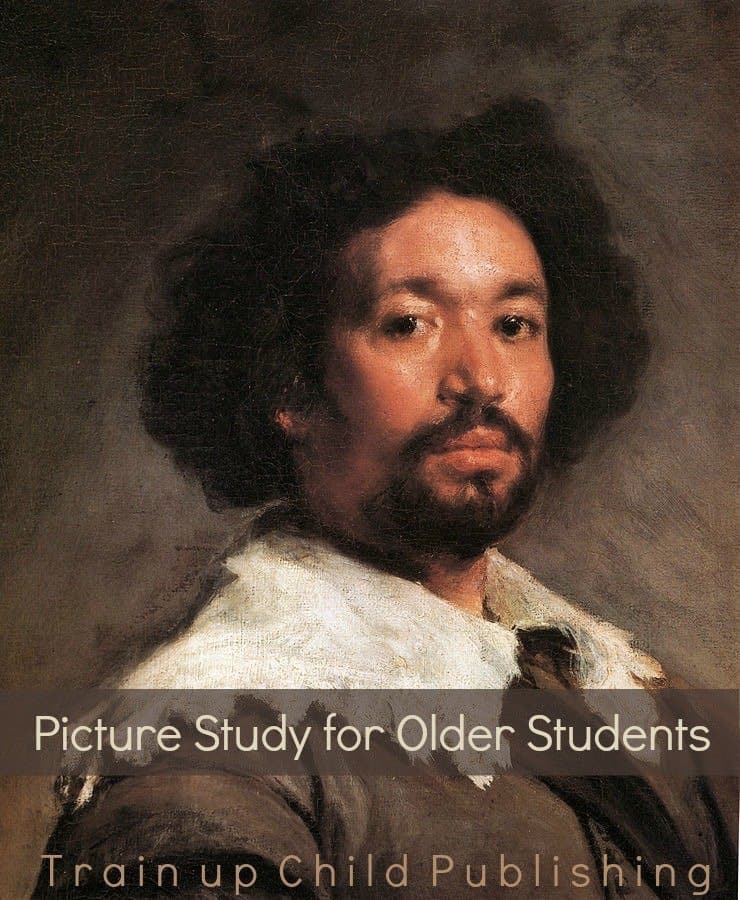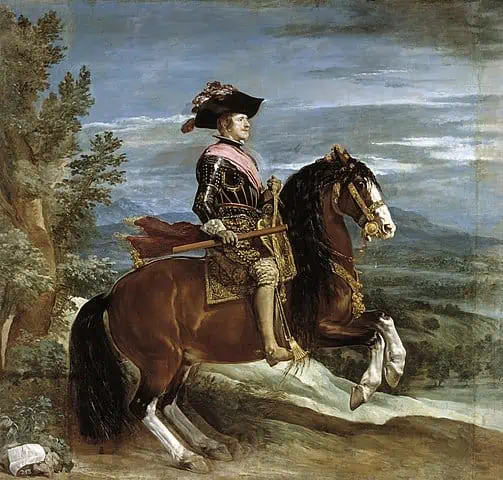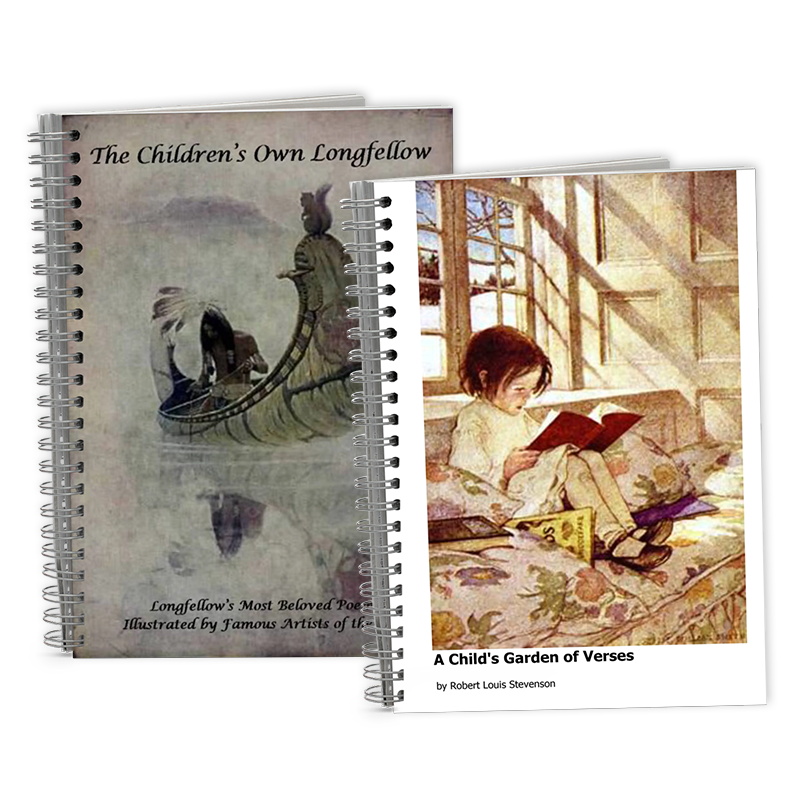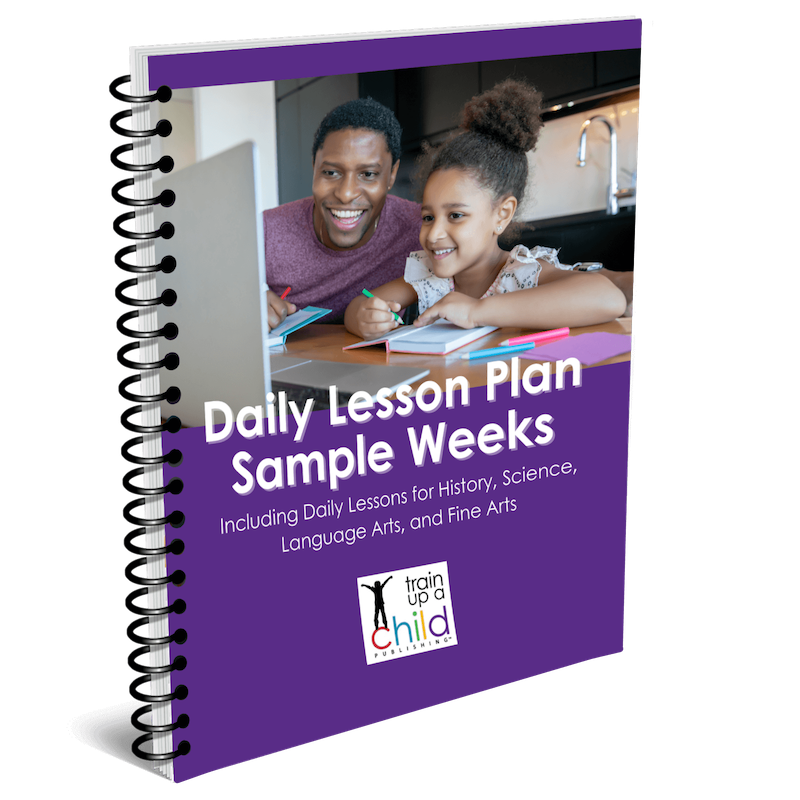Picture Study for Older Students – Charlotte Mason Mondays

Although not addressed directly in Charlotte Mason’s original Homeschooling Series, picture study for older students is just as valuable as for our younger ones. Through consistent observation and enjoyment of a variety of artists’ work in the younger years, some middle school and high school students are ready to take on a little more detailed and guided study of artwork. Even if you have not been regular in your picture study, it is never too late to begin! Especially if you have an artistically gifted child or two, don’t neglect teaching picture study for your older students.
Integrate picture study with your history
So where do we fit it into our study? Here’s how we do it: we organize our research of artists and their work chronologically according to which unit in history we study. Charlotte Mason suggests studying six or so works of one artist during a term. We modify that a little and study the works of one artist per unit.
We suggest in our unit programs that you study one artist per unit, so you would study about nine artists yearly. But picture study for older students who love art might look slightly different. If your older student wants to study more artists during the year or more at a time, I would let them!
Charlotte’s primary goal was for students to experience art for themselves, not become experts on the artist or a particular piece of art. For older students, however, especially those particularly interested in art, you might consider a more structured approach to their picture study.
If picture study is a new addition to your academic education, take a look at last week’s post to help you begin. If you have older children, say middle or high school students, a little guidance might be what you need to get started. (The following is taken from our Middle School Lesson Plans.)
How to Critique and Write About Art
This method is simplified from Edmund Burke Feldman’s method of evaluating art, commonly known to the art world as Feldman’s Method of Critiquing Art. You may use this as a guide in having your students study and write about art.
Always remember you may tailor this to the level and interest of your students; you may want to choose just a few questions for your student to write about if it is the first time he has studied and/or written about artwork, or you may use these questions as discussion prompts.
If you decide to use this guide, talk through it a few times before you actually have your student create a written interpretation. If you choose to have him write, have him respond in paragraph form in complete sentences.
Now Let’s Try Studying this Picture Together!
We’ll work through this critique together using this painting by Diego Velázquez:

Equestrian Portrait of Philip IV. (2023, May 2). In Wikipedia. https://en.wikipedia.org/wiki/Equestrian_Portrait_of_Philip_IV
1. List
State the artist’s name, the piece’s title, and, if you know it, its current location.
This is Diego Velázquez’ Equestrian Portrait of King Philip IV in the Museo del Prado, Madrid.
Editor’s note: I was fortunate to see this painting in person a few years ago, and it is HUGE. It’s roughly 10 feet by 10 feet!
2. Describe
Describe the work to someone as if the person you were talking to could not see it. Stick to the facts, listing everything you see in the picture.
Answers will differ here—if your student is new to this, please be positive about his or her answers. It is okay to ask questions to help him if needed, such as, what do you notice about the background? What is in the foreground of the painting? What else do you notice besides the horse and rider in the painting?
Example:
In the center of this picture is a man on horseback. They appear to be on a hill or on the side of a mountain, as you can see small trees in the background and one behind the man and horse. The man is dressed ornately, and he is looking straight ahead. From the title of the painting, he must be King Philip. The horse looks strong, and he is standing on his hind legs. There is not a lot of light in the picture; it looks as if it is very early morning or late afternoon. Or maybe it’s an overcast day. In the left hand corner of the painting, it looks as if there is an open piece of paper that has been folded in half.
3. Note First Impression
What is your very first reaction to the piece? (Note: There are no right or wrong answers here!)
The king looks strong, serious, and determined.
4. Analyze the piece
Here you want to look at what the artist has done to achieve certain effects. You could refer to your first impressions and figure out how the artwork caused you to react. (Again, this level of picture study is for older students!)
Possible questions:
- How are the elements of art (color, shape, line, texture, space) and the principles of design (balance, contrast, emphasis, movement/rhythm) used in this artwork?
- Questions you might ask in the discussion here to help your student include process this:
-
- What colors did the artist use in this painting?
- Did the artist use color to lead you to look at some particular object in the painting?
- What do you notice about how the artist uses light in the picture?
- Do you see any movement in the picture?
- What strong contrasts do you see in light and color in this picture?
- What do you notice about the artist’s choice of materials?
- What grabs your attention when you first look at the piece?
-
Example:
In this portrait of King Philip IV of Spain, King Philip on his horse is obviously the most important part of the painting. I can tell because he is painted so large, and the artist put him in the middle of the painting.
The horse is moving; he is standing on his hind legs. He looks spirited and powerful, but the King on his back looks even more powerful than the horse. The artist uses light to balance the king’s glistening armor with the horse’s glistening coat. King Philip looks very serious.
5. Interpret the piece
All art is about something. It may be about light, color, the subject matter, or even a political statement of some kind. Some art is easy to figure out, and some is more symbolic.
Here are some questions to prompt your older student’s study of the picture:
- What is the theme or subject of the work?
- What is the work about; what do you think it means?
- Why do you think the artist created this work?
- What do you think the artist’s worldview is? (this question may or may not be relevant to all of the artwork you evaluate…)
Example:
The King is painted high on a hill. Everything else is literally beneath him. He confidently looks straight ahead, controlling his powerful and spirited horse. He seems ready for whatever awaits him. His expression looks pensive and serious rather than relaxed and happy, for example—the kind of look you would want to see in your leader. (In fact, it was customary at this time to paint royals on horseback, which was a symbol of authority.) Perhaps the purpose of this painting was to help King Philip’s subjects to have confidence in him as a strong leader.
(By the way, the paper painted on the lower left would have been the place where Velázquez presumably had signed the painting.) It’s a mystery, isn’t it?
Helpful Resources
For help in learning more about art, I recommend the Art for Children Series by Ernest Raboff. Although it is out of print, used copies are readily available from Amazon.com. Each book offers full-color, large-scale copies of each author’s work and interesting and pertinent facts about the artist’s life, background, and study of each featured work. They are listed as helpful for ages 9-12, but I think they’re timeless.
I learned tons from these books! (As every homeschool mom knows, the best way to learn about anything is to read a kid’s book about it, right?)
You might be able to find these books in your public library system. If not, you may click on the following graphics if you’d like to see buying options.
I collected many of these used over time. Note that you don’t have to have these books to do picture study.
But they are really helpful if you don’t have any prior experience and would like to have (and help your kids have) a deeper understanding of art.
Do you do picture study for older students at your house? Would you like to start?



Dana, I just pinned this and posted it to my blog’s FB page. Thanks so much!
Thank you, Ellen! Have you ever read I, Juan de Pareja?>? It’s an EXCELLENT book that was a family favorite about Juan de Pareja, the slave of the Spanish artist Velázquez. His portrait (Juan de Pareja’s) is at the top of this post. Reading the book and then looking at that portrait made my kids see them as ‘real’ people – which is the whole point of our literature-based studies. 🙂 Thanks for sharing.
Dana, This outline is very helpful. I want to print this out for future reference. 🙂 My daughter is in 5th grade, and we’re starting more indepth analysis. This is the direction I want to go — writing about academic subjects.
Hi Jimmie! Thank you; I’m glad it was helpful. Sprite is fortunate to have a mom who is planning ahead. Those years go awfully fast once children reach late elementary! Thank you for stopping by.